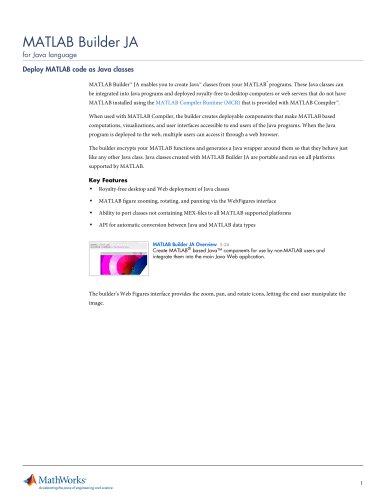
Catalog excerpts
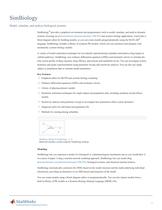
SimBiology Model, simulate, and analyze biological systems SimBiology® provides a graphical environment and programmatic tools to model, simulate, and analyze dynamic systems, focusing on pharmacokinetic/pharmacodynamic (PK/PD) and systems biology applications. It provides a block diagram editor for building models, or you can create models programmatically using the MATLAB® language. SimBiology includes a library of common PK models, which you can customize and integrate with mechanistic systems biology models. A variety of model exploration techniques let you identify optimal dosing schedules and putative drug targets in cellular pathways. SimBiology uses ordinary differential equations (ODEs) and stochastic solvers to simulate the time course profile of drug exposure, drug efficacy, and enzyme and metabolite levels. You can investigate system dynamics and guide experimentation using parameter sweeps and sensitivity analysis. You can also use single subject or population data to estimate model parameters. Key Features ▪ Graphical editor for PK/PD and systems biology modeling ▪ Ordinary differential equations (ODEs) and stochastic solvers ▪ Library of pharmacokinetic models ▪ Parameter estimation techniques for single subject and population data, including nonlinear mixed-effects models ▪ Sensitivity analysis and parameter sweeps to investigate how parameters affect system dynamics ▪ Diagnostic plots for individual and population fits ▪ Methods for creating dosing schedules Building a Model in SimBiology 12:56 Build and simulate a model using the SimBiology desktop. Modeling SimBiology lets you represent a model of a biological or a pharmacological mechanism just as you would draw it on a piece of paper. Using a reaction network modeling approach, SimBiology lets you model drug pharmacokinetics and pharmacodynamics (PK/PD), biological systems, and chemical reaction kinetics. SimBiology automatically constructs the ODEs based on the model structure and the math underlying individual interactions, providing an alternative to an ODE-based representation of the model. You can create models using a block diagram editor or programmatically. You can also import models from a built-in library of PK models or a Systems Biology Markup Language (SBML) file.
Open the catalog to page 1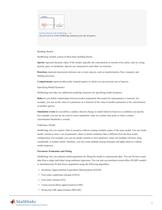
Getting Started with SimBiology 5:48 Get an overview of the SimBiology desktop layout and navigation. Building Models SimBiology models consist of three basic building blocks: Species represent dynamic states of the model, typically the concentration or amount of an entity, such as a drug, protein, gene, or metabolite. Species are connected to each other via reactions. Reactions represent interactions between one or more species, such as transformation, flow, transport, and binding processes. Compartments represent physically isolated regions in which you can associate sets of species....
Open the catalog to page 2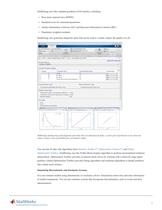
SimBiology provides standard goodness-of-fit statistics, including: ■ Root mean squared error (RMSE) ■ Standard errors for estimated parameters ■ Akaike Information Criterion (AIC) and Bayesian Information Criterion (BIC) ■ Population weighted residuals SimBiology also generates diagnostic plots that can be used to visually inspect the quality of a fit. Time: Time l>l ► Home t Project (Training Pre-jeei_$ol,j.ion) » Taik; * Parameter Fir (OneCrnt PBCJ Estimation Method: Estimated Parameters: [Collaps^l Component Name Double dkkio enter name or drag from f... 1.0 Parameter Initial Estimate...
Open the catalog to page 3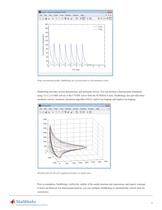
SimBiology provides several deterministic and stochastic solvers. You can perform a deterministic simulation using MATLAB ODE solvers or the CVODE solver from the SUNDIALS suite. SimBiology also provides three stochastic solvers: stochastic simulation algorithm (SSA), explicit tau-leaping, and implicit tau-leaping. File Edit View Insert Tools Desktop Window Desktop Window Help ^ 3D phase plot of cell-cycle regulation dynamics at steady state. Prior to simulation, SimBiology verifies the validity of the model structure and expressions, and reports warnings if errors are detected. For...
Open the catalog to page 4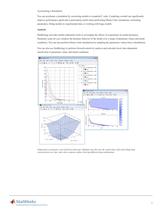
You can accelerate a simulation by converting models to compiled C code. Compiling a model can significantly improve performance speed and is particularly useful when performing Monte Carlo simulations, estimating parameters, fitting models to experimental data, or working with large models. SimBiology provides model exploration tools to investigate the effects of a parameter on model dynamics. Parameter scans let you visualize the dynamic behavior of the model over a range of parameter values and initial conditions. You can also perform Monte Carlo simulations by sampling the parameters...
Open the catalog to page 5
Resources Product Details, Examples, and System Requirements www.mathworks.com/products/simbiology Online User Community www.mathworks.com/matlabcentral Trial Software www.mathworks.com/trialrequest Training Services www.mathworks.com/training Sales www.mathworks.com/contactsales Third-Party Products and Services www.mathworks.com/connections Technical Support www.mathworks.com/support Worldwide Contacts www.mathworks.com/contact © 2012 The MathWorks, Inc. MATLAB and Simulink are registered trademarks of The MathWorks, Inc. See www.mathworks.com/trademarks for a list of additional...
Open the catalog to page 6All The MathWorks catalogs and technical brochures
-
MATLAB Production Server
6 Pages
-
Database Toolbox
4 Pages
-
MATLAB Report Generator
4 Pages
-
Stateflow
8 Pages
-
SimEvents
7 Pages
-
SimDriveline
7 Pages
-
SimHydraulics
7 Pages
-
SimPowerSystems
8 Pages
-
Simulink Control Design
5 Pages
-
Aerospace Blockset
5 Pages
-
SimRF
6 Pages
-
Simulink Coder
6 Pages
-
Embedded Coder
8 Pages
-
Simulink PLC Coder
4 Pages
-
Fixed-Point Designer
9 Pages
-
MATLAB Coder
5 Pages
-
Simulink 3D Animation
10 Pages
-
Gauges Blockset
2 Pages
-
Simulink Report Generator
3 Pages
-
Polyspace Bug Finder
6 Pages
-
global-optimization-toolbox
10 Pages
-
Phased Array System Toolbox
9 Pages
-
OPC Toolbox
5 Pages
-
Simulink Design Verifier
7 Pages
-
Simulink Design Optimization
10 Pages
-
Filter Design HDL Coder
5 Pages
-
Bioinformatics Toolbox
9 Pages
-
Computer Vision System Toolbox
10 Pages
-
DSP System Toolbox
11 Pages
-
Fuzzy Logic Toolbox
5 Pages
-
Polyspace Client for C/C++
5 Pages
-
xPC Target
5 Pages
-
SimMechanics
7 Pages
-
Simscape
7 Pages
-
Simulink
6 Pages
-
Data Acquisition Toolbox
8 Pages
-
Image Processing Toolbox
7 Pages
-
Signal Processing Toolbox
10 Pages
-
Control System Toolbox
6 Pages
-
Symbolic Math Toolbox?
6 Pages
-
Parallel Computing Toolbox?
7 Pages
-
MATLAB®
6 Pages
-
Mapping Toolbox 3.2
7 Pages
-
Instrument Control Toolbox
7 Pages
-
Optimization Toolbox 6.0
14 Pages
Archived catalogs
-
MATLAB Release Notes
505 Pages
-
C and Fortran API Reference
263 Pages
-
External Interfaces
649 Pages
-
Function Reference: Volume 3 (P-Z)
1696 Pages
-
Function Reference: Volume 2 (F-O)
1568 Pages
-
Function Reference: Volume 1 (A-E)
1298 Pages
-
Creating Graphical User Interfaces
520 Pages
-
3-D Visualization
212 Pages
-
Graphics
667 Pages
-
MATLAB Programming Tips
66 Pages
-
Programming Fundamentals
840 Pages
-
Data Analysis
220 Pages
-
Mathematics
316 Pages
-
MATLAB® Getting Started Guide
250 Pages



